Epidemiology of Hip Fractures Due to Falls
Abstract
1. Introduction
2. Methods
2.1. Study Design
2.2. Study Population
2.3. Data Source
2.4. Measures
2.5. Statistical Analysis
2.6. Ethics Statement
3. Results
4. Discussion
Strengths and Limitations of the Study
5. Conclusions
Author Contributions
Funding
Institutional Review Board Statement
Informed Consent Statement
Data Availability Statement
Acknowledgments
Conflicts of Interest
References
- Schwartz, A.V.; Kelsey, J.L.; Maggi, S.; Tuttleman, M.; Ho, S.C.; Jónsson, P.V.; Poór, G.; Sisson de Castro, J.A.; Xu, L.; Matkin, C.C.; et al. International variation in the incidence of hip fractures: Cross-national project on osteoporosis for the World Health Organization Program for Research on Aging. Osteoporos. Int. 1999, 9, 242–253. [Google Scholar] [CrossRef]
- Zhang, C.; Feng, J.; Wang, S.; Gao, P.; Xu, L.; Zhu, J.; Jia, J.; Liu, L.; Liu, G.; Wang, J.; et al. Incidence of and trends in hip fracture among adults in urban China: A nationwide retrospective cohort study. PLoS Med. 2020, 17, e1003180. [Google Scholar] [CrossRef]
- Cheng, S.Y.; Levy, A.R.; Lefaivre, K.A.; Guy, P.; Kuramoto, L.; Sobolev, B. Geographic trends in incidence of hip fractures: A comprehensive literature review. Osteoporos. Int. 2011, 22, 2575–2586. [Google Scholar] [CrossRef] [PubMed]
- Brauer, C.A.; Coca-Perraillon, M.; Cutler, D.M.; Rosen, A.B. Incidence and mortality of hip fractures in the United States. JAMA 2009, 302, 1573–1579. [Google Scholar] [CrossRef] [PubMed]
- Marks, R. Hip fracture epidemiological trends, outcomes, and risk factors, 1970–2009. Int. J. Gen. Med. 2010, 3, 1–17. [Google Scholar] [CrossRef] [PubMed]
- Gullberg, B.; Johnell, O.; Kanis, J.A. World-wide projections for hip fracture. Osteoporos. Int. 1997, 7, 407–413. [Google Scholar] [CrossRef]
- Marques, A.; Lourenço, Ó.; da Silva, J.A. Portuguese Working Group for the Study of the Burden of Hip Fractures in Portugal. The burden of osteoporotic hip fractures in Portugal: Costs, health related quality of life and mortality. Osteoporos. Int. 2015, 26, 2623–2630. [Google Scholar] [CrossRef]
- Hektoen, L.F.; Saltvedt, I.; Sletvold, O.; Helbostad, J.L.; Lurås, H.; Halsteinli, V. One-year health and care costs after hip fracture for home-dwelling elderly patients in Norway: Results from the Trondheim Hip Fracture Trial. Scand. J. Public Health 2016, 44, 791–798. [Google Scholar] [CrossRef]
- Mitchell, R.; Draper, B.; Harvey, L.; Wadolowski, M.; Brodaty, H.; Close, J. Comparison of hospitalised trends, treatment cost and health outcomes of fall-related hip fracture for people aged ≥ 65 years living in residential aged care and the community. Osteoporos. Int. 2019, 30, 311–321. [Google Scholar] [CrossRef]
- Ferris, H.; Merron, G.; Coughlan, T. 1 year mortality after hip fracture in an Irish urban trauma centre. BMC Musculoskelet. Disord. 2023, 24, 487. [Google Scholar] [CrossRef]
- Dimet-Wiley, A.; Golovko, G.; Watowich, S.J. One-Year Postfracture Mortality Rate in Older Adults With Hip Fractures Relative to Other Lower Extremity Fractures: Retrospective Cohort Study. JMIR Aging 2022, 5, e32683. [Google Scholar] [CrossRef]
- Dyer, S.M.; Crotty, M.; Fairhall, N.; Magaziner, J.; Beaupre, L.A.; Cameron, I.D.; Sherrington, C. Fragility Fracture Network (FFN) Rehabilitation Research Special Interest Group. A critical review of the long-term disability outcomes following hip fracture. BMC Geriatr. 2016, 16, 158. [Google Scholar] [CrossRef] [PubMed]
- Tang, V.L.; Sudore, R.; Cenzer, I.S.; Boscardin, W.J.; Smith, A.; Ritchie, C.; Wallhagen, M.; Finlayson, E.; Petrillo, L.; Covinsky, K. Rates of Recovery to Pre-Fracture Function in Older Persons with Hip Fracture: An Observational Study. J. Gen. Intern. Med. 2017, 32, 153–158. [Google Scholar] [CrossRef] [PubMed]
- Bahadori, S.; Middleton, R.G.; Wainwright, T.W. Using Gait Analysis to Evaluate Hip Replacement Outcomes-Its Current Use, and Proposed Future Importance: A Narrative Review. Healthcare 2022, 10, 2018. [Google Scholar] [CrossRef]
- Patterson, J.T.; Wier, J.; Kumaran, P.; Adamczyk, A. Rising incidence of acute total hip arthroplasty for primary and adjunctive treatment of acetabular fracture in older and middle-aged adults. Eur. J. Orthop. Surg. Traumatol. 2023. [Google Scholar] [CrossRef]
- Salaha, Z.F.M.; Ammarullah, M.I.; Abdullah, N.N.A.A.; Aziz, A.U.A.; Gan, H.S.; Abdullah, A.H.; Abdul Kadir, M.R.; Ramlee, M.H. Biomechanical Effects of the Porous Structure of Gyroid and Voronoi Hip Implants: A Finite Element Analysis Using an Experimentally Validated Model. Materials 2023, 16, 3298. [Google Scholar] [CrossRef]
- Zeelenberg, M.L.; Den Hartog, D.; Panneman, M.J.M.; Polinder, S.; Verhofstad, M.H.J.; Van Lieshout, E.M.M. Trends in incidence, health care consumption, and costs for proximal femoral fractures in the Netherlands between 2000 and 2019: A nationwide study. Osteoporos. Int. 2023, 34, 1389–1399. [Google Scholar] [CrossRef]
- Dhanwal, D.K.; Dennison, E.M.; Harvey, N.C.; Cooper, C. Epidemiology of hip fracture: Worldwide geographic variation. Indian. J. Orthop. 2011, 45, 15–22. [Google Scholar] [CrossRef]
- WHO. Falls; WHO: Geneva, Switzerland, 2018; Available online: https://www.who.int/news-room/fact-sheets/detail/falls#:~:text=Key%20facts,greatest%20number%20of%20fatal%20falls (accessed on 31 May 2023).
- GBD 2017 Causes of Death Collaborators. Global, regional, and national age-sex-specific mortality for 282 causes of death in 195 countries and territories, 1980–2017: A systematic analysis for the Global Burden of Disease Study 2017. Lancet 2018, 392, 1736–1788. [Google Scholar] [CrossRef]
- Parkkari, J.; Kannus, P.; Palvanen, M.; Natri, A.; Vainio, J.; Aho, H.; Vuori, I.; Järvinen, M. Majority of hip fractures occur as a result of a fall and impact on the greater trochanter of the femur: A prospective controlled hip fracture study with 206 consecutive patients. Calcif. Tissue Int. 1999, 65, 183–187. [Google Scholar] [CrossRef]
- James, S.L.; Lucchesi, L.R.; Bisignano, C.; Castle, C.D.; Dingels, Z.V.; Fox, J.T.; Hamilton, E.B.; Henry, N.J.; Krohn, K.J.; Liu, Z.; et al. The global burden of falls: Global, regional and national estimates of morbidity and mortality from the Global Burden of Disease Study 2017. Inj. Prev. 2020, 26, i3–i11. [Google Scholar] [CrossRef]
- Harmsen, A.M.; Egea-Gámez, R.M.; Garssen, F.P.; Van Dulken, E.; Toor, A.; Bloemers, F.W. Fall-related injuries in Amsterdam: Frail older women at risk. J. Women Aging 2016, 28, 489–497. [Google Scholar] [CrossRef][Green Version]
- Bhimjiyani, A.; Neuburger, J.; Jones, T.; Ben-Shlomo, Y.; Gregson, C.L. Inequalities in hip fracture incidence are greatest in the North of England: Regional analysis of the effects of social deprivation on hip fracture incidence across England. Public Health 2018, 162, 25–31. [Google Scholar] [CrossRef] [PubMed]
- Haagsma, J.A.; Charalampous, P.; Ariani, F.; Gallay, A.; Moesgaard Iburg, K.; Nena, E.; Ngwa, C.H.; Rommel, A.; Zelviene, A.; Abegaz, K.H.; et al. The burden of injury in Central, Eastern, and Western European sub-region: A systematic analysis from the Global Burden of Disease 2019 Study. Arch. Public Health 2022, 80, 142. [Google Scholar] [CrossRef] [PubMed]
- GBD 2019 Diseases and Injuries Collaborators. Global burden of 369 diseases and injuries in 204 countries and territories, 1990-2019: A systematic analysis for the Global Burden of Disease Study 2019. Lancet 2020, 396, 1204–1222. [Google Scholar] [CrossRef]
- Stevens, G.A.; Alkema, L.; Black, R.E.; Boerma, J.T.; Collins, G.S.; Ezzati, M.; Grove, J.T.; Hogan, D.R.; Hogan, M.C.; Horton, R.; et al. Guidelines for Accurate and Transparent Health Estimates Reporting: The GATHER statement. Lancet 2016, 388, e19–e23. [Google Scholar] [CrossRef]
- United Nations Development Programme. Human Development Index (HDI). Available online: https://hdr.undp.org/ (accessed on 5 June 2023).
- Kim, H.J.; Fay, M.P.; Feuer, E.J.; Midthune, D.N. Permutation tests for joinpoint regression with applications to cancer rates. Stat. Med. 2000, 19, 335–351. [Google Scholar] [CrossRef]
- Lerman, P.M. Fitting segmented regression models by grid search. Appl. Stat. 1980, 29, 77–84. [Google Scholar] [CrossRef]
- Clegg, L.X.; Hankey, B.F.; Tiwari, R.; Feuer, E.J.; Edwards, B.K. Estimating average annual per cent change in trend analysis. Stat. Med. 2009, 28, 3670–3682. [Google Scholar] [CrossRef]
- Kim, H.J.; Fay, M.P.; Yu, B.; Barrett, M.J.; Feuer, E.J. Comparability of segmented line regression models. Biometrics 2004, 60, 1005–1014. [Google Scholar] [CrossRef]
- GBD 2019 Fracture Collaborators. Global, regional, and national burden of bone fractures in 204 countries and territories, 1990–2019: A systematic analysis from the Global Burden of Disease Study 2019. Lancet Healthy Longev. 2021, 2, e580–e592. [Google Scholar] [CrossRef]
- Werner, M.; Macke, C.; Gogol, M.; Krettek, C.; Liodakis, E. Differences in hip fracture care in Europe: A systematic review of recent annual reports of hip fracture registries. Eur. J. Trauma. Emerg. Surg. 2022, 48, 1625–1638. [Google Scholar] [CrossRef]
- Ormeño Illanes, J.C.R.; Quevedo Langenegger, I. Higher latitude and lower solar radiation influence on hip fracture admissions in Chilean older population. Osteoporos. Int. 2021, 32, 2033–2041. [Google Scholar] [CrossRef]
- Ambrose, A.F.; Cruz, L.; Paul, G. Falls and Fractures: A systematic approach to screening and prevention. Maturitas 2015, 82, 85–93. [Google Scholar] [CrossRef]
- Wu, X.; Tian, M.; Zhang, J.; Yang, M.; Gong, X.; Liu, Y.; Li, X.; Lindley, R.I.; Anderson, M.; Peng, K.; et al. The effect of a multidisciplinary co-management program for the older hip fracture patients in Beijing: A “pre- and post-” retrospective study. Arch. Osteoporos. 2019, 14, 43. [Google Scholar] [CrossRef]
- Looker, A.C.; Melton, L.J., 3rd; Harris, T.B.; Borrud, L.G.; Shepherd, J.A. Prevalence and trends in low femur bone density among older US adults: NHANES 2005–2006 compared with NHANES III. J. Bone Miner. Res. 2010, 25, 64–71. [Google Scholar] [CrossRef]
- Kirilova, E.; Kirilov, N.; Bischoff, F.; Vladeva, S.; Nikolov, N.; Nikolov, M.; Batalov, Z.; Batalov, A.; Kinov, P.; Kovachev, V.; et al. Prevalence of low bone mineral density at axial sites and fracture risk in Bulgarian population. Orthop. Rev. 2022, 14, 57622. [Google Scholar] [CrossRef]
- Grisso, J.A.; Kelsey, J.L.; Strom, B.L.; Chiu, G.Y.; Maislin, G.; O’Brien, L.A.; Hoffman, S.; Kaplan, F. Risk factors for falls as a cause of hip fracture in women. The Northeast Hip Fracture Study Group. N. Engl. J. Med. 1991, 324, 1326–1331. [Google Scholar] [CrossRef]
- Azagra, R.; López-Expósito, F.; Martin-Sánchez, J.C.; Aguyé, A.; Moreno, N.; Cooper, C.; Díez-Pérez, A.; Dennison, E.M. Changing trends in the epidemiology of hip fracture in Spain. Osteoporos. Int. 2014, 25, 1267–1274. [Google Scholar] [CrossRef]
- Yu, Y.; Wang, Y.; Hou, X.; Tian, F. Recent advances in the identification of related factors and preventive strategies of hip fracture. Front. Public Health 2023, 11, 1006527. [Google Scholar] [CrossRef]
- Karampampa, K.; Ahlbom, A.; Michaëlsson, K.; Andersson, T.; Drefahl, S.; Modig, K. Declining incidence trends for hip fractures have not been accompanied by improvements in lifetime risk or post-fracture survival—A nationwide study of the Swedish population 60 years and older. Bone 2015, 78, 55–61. [Google Scholar] [CrossRef] [PubMed]
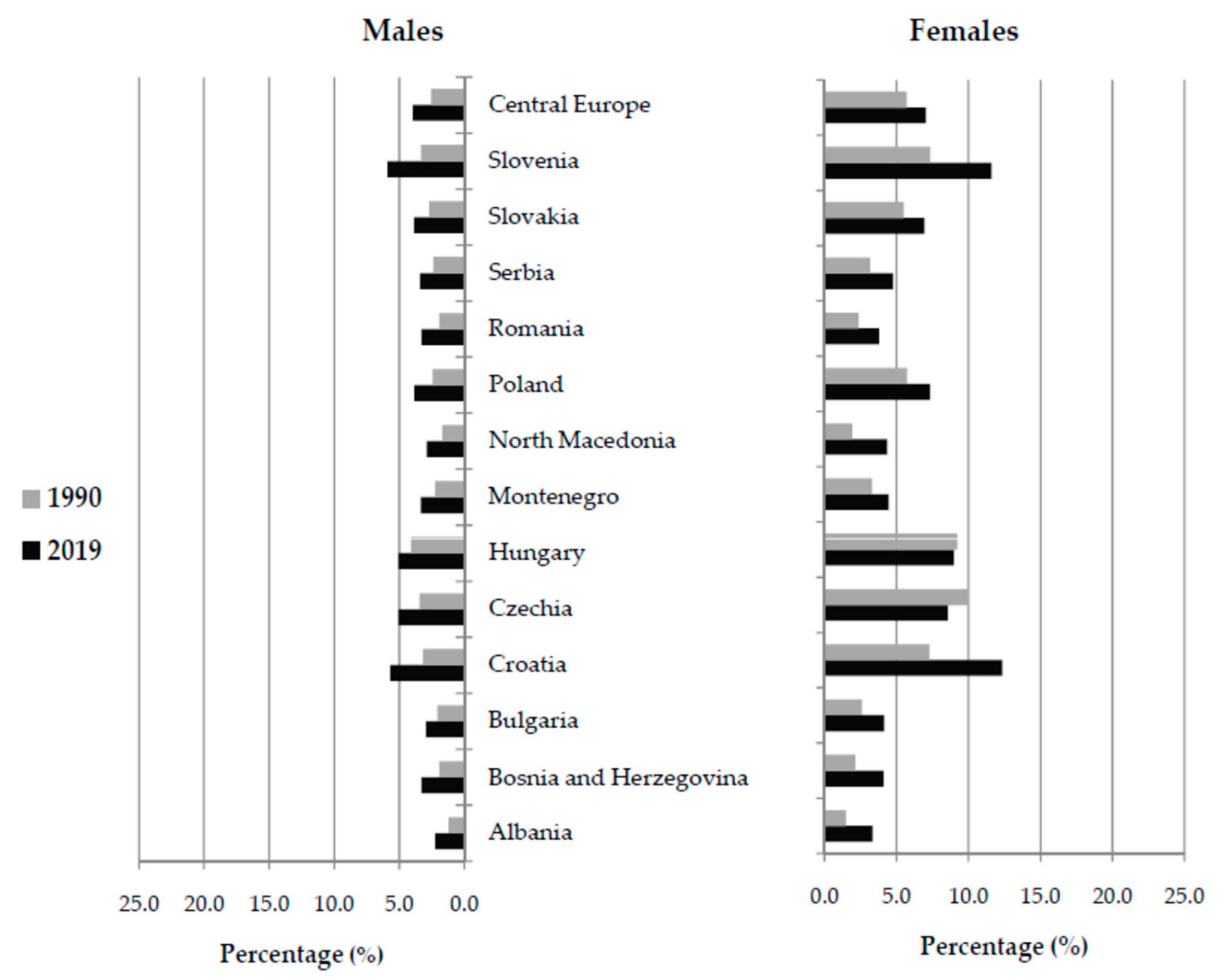
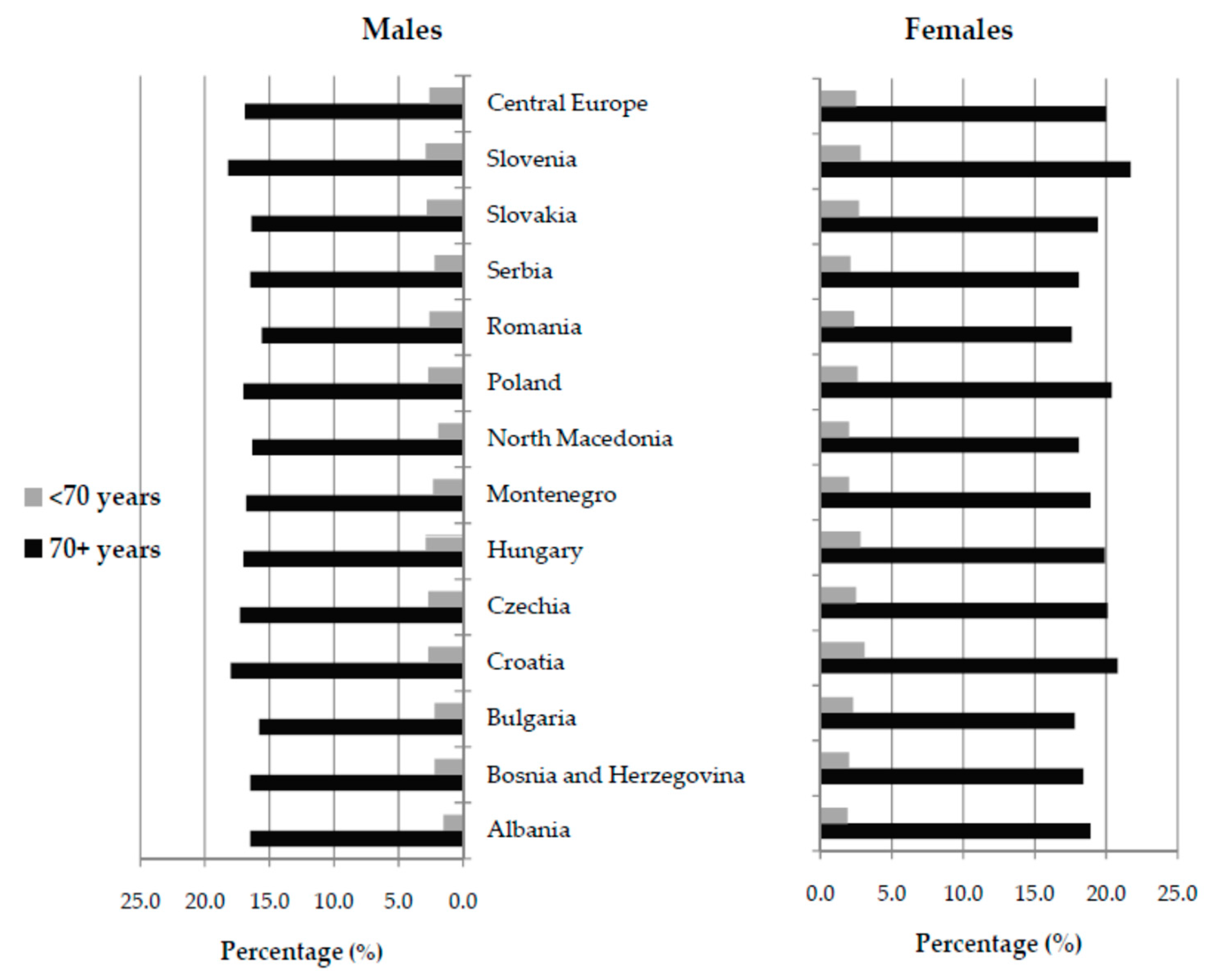
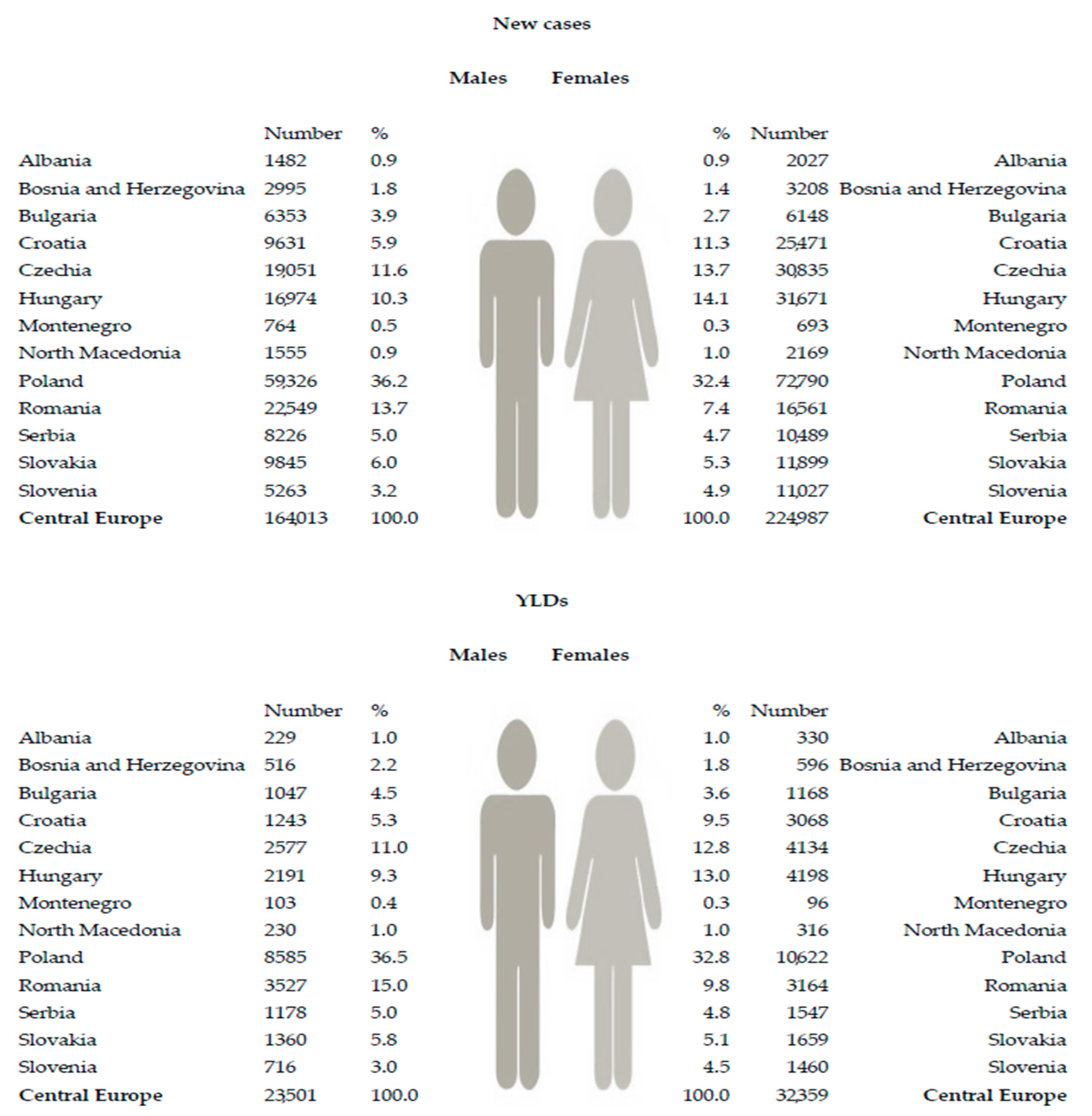
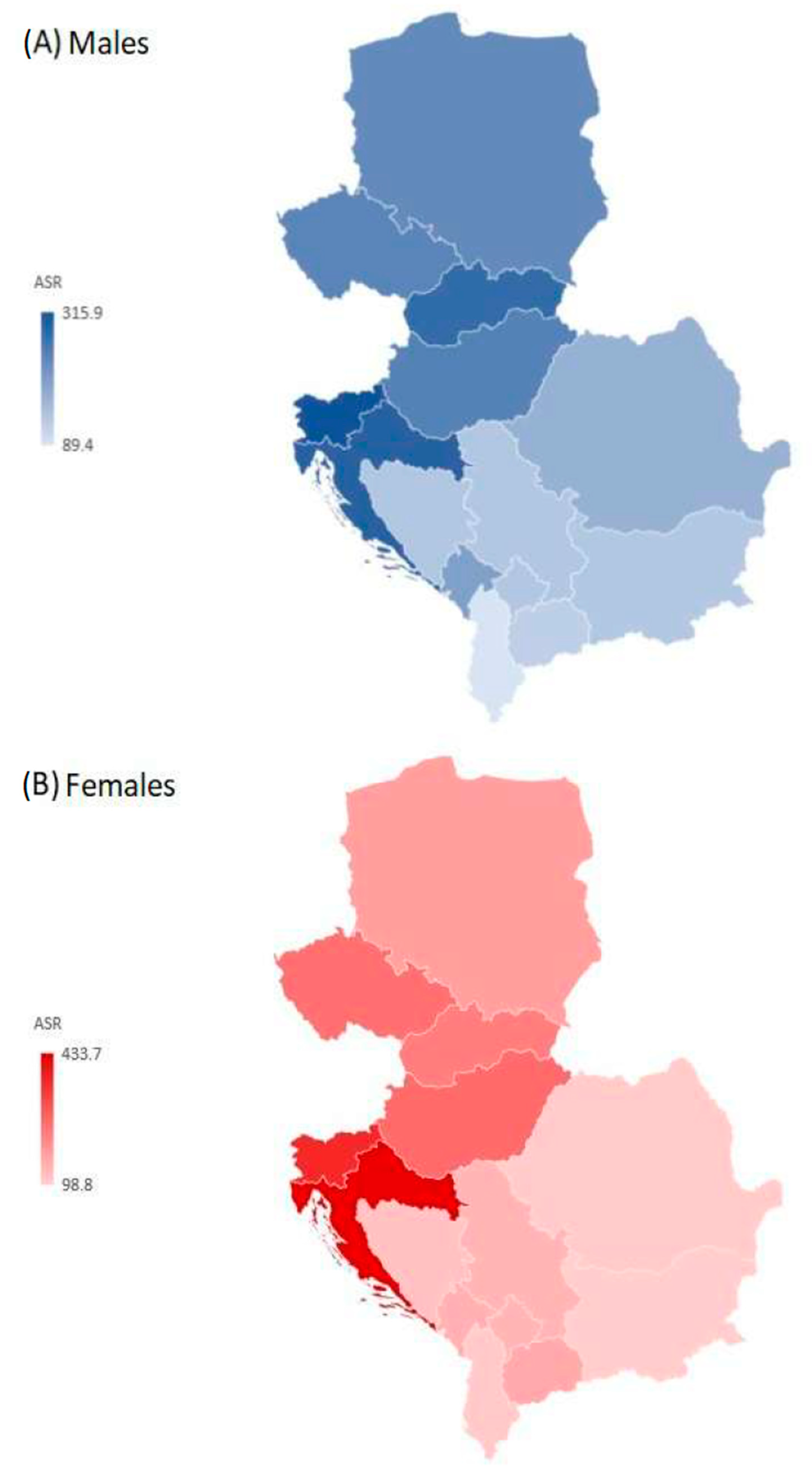
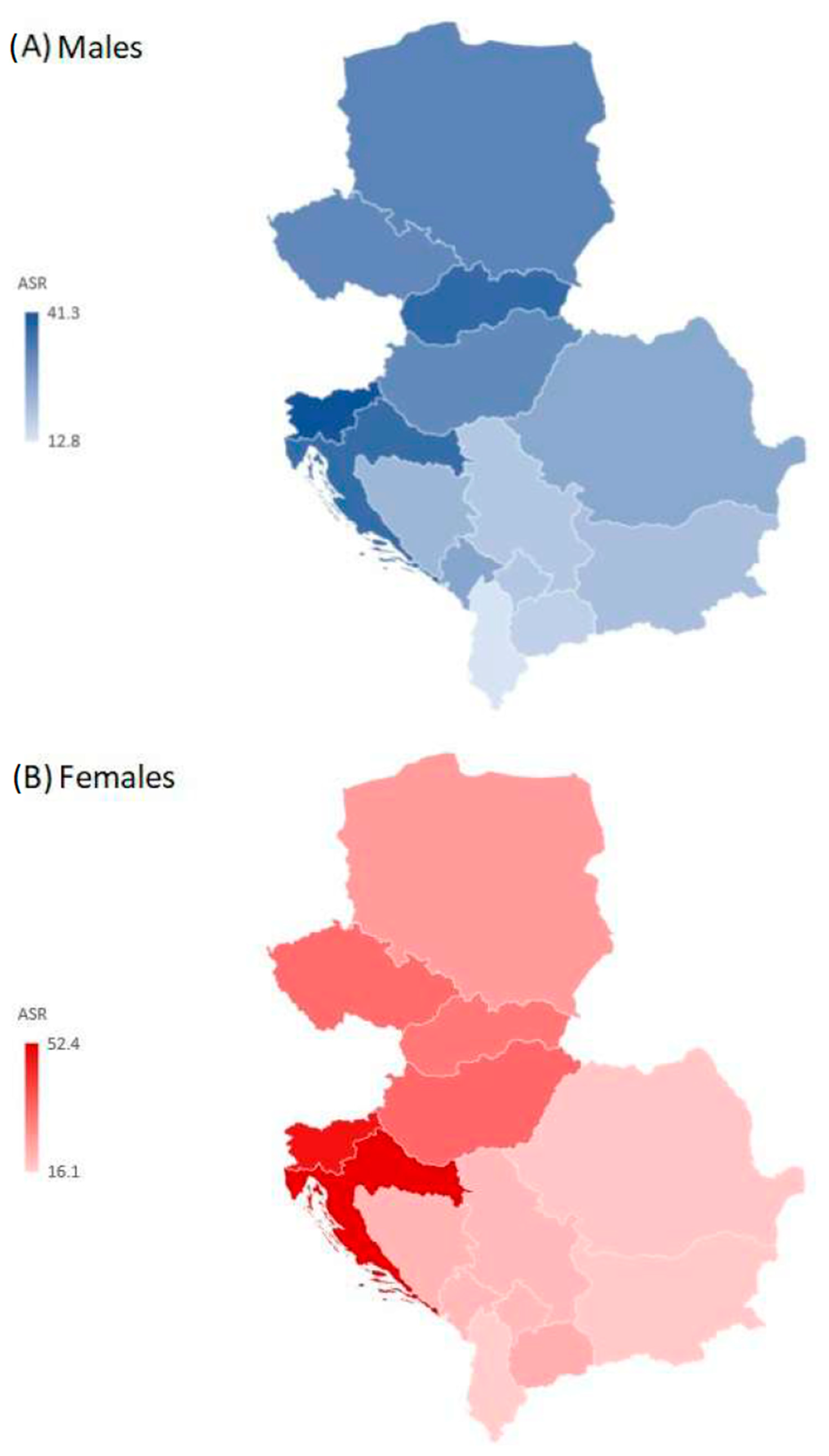
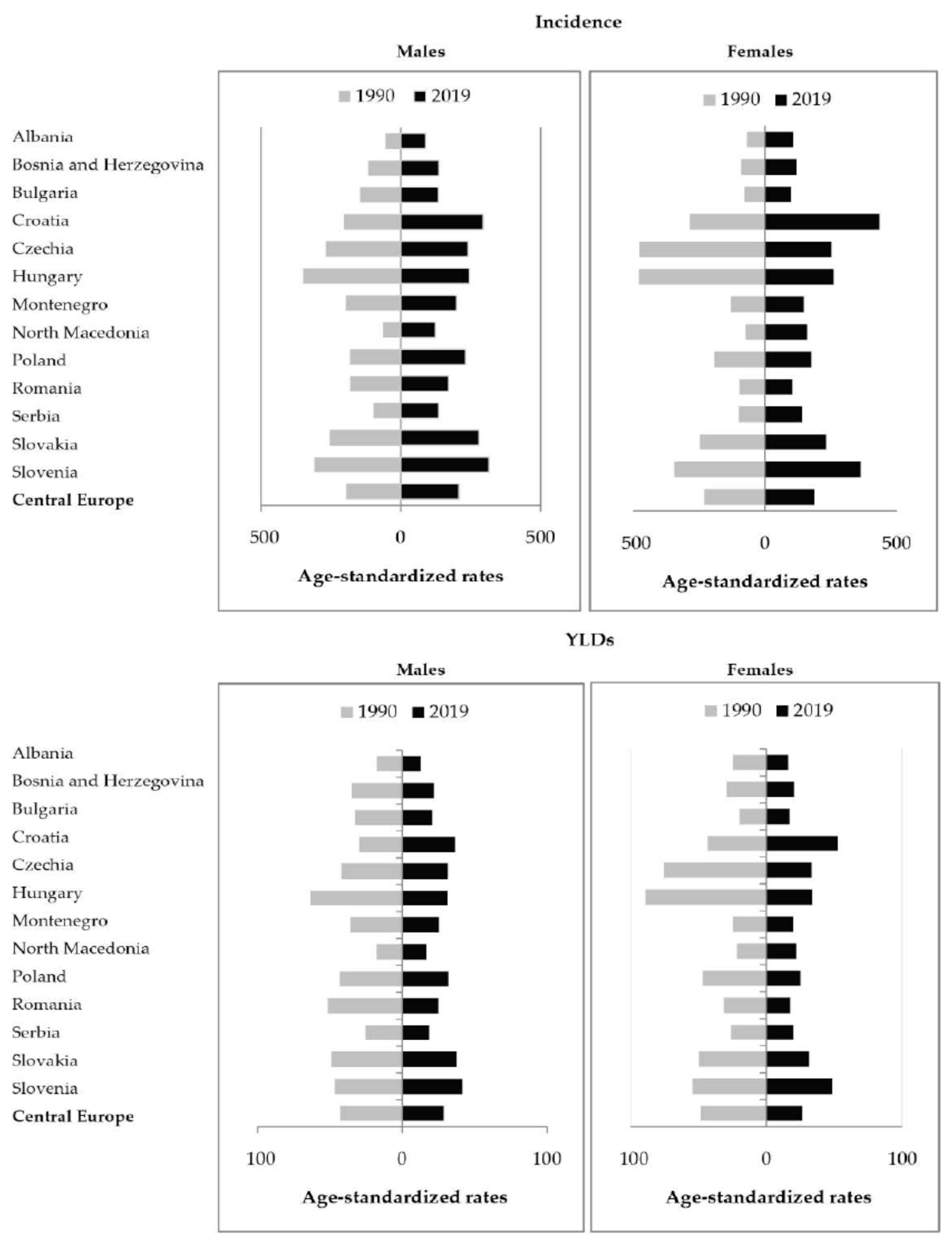
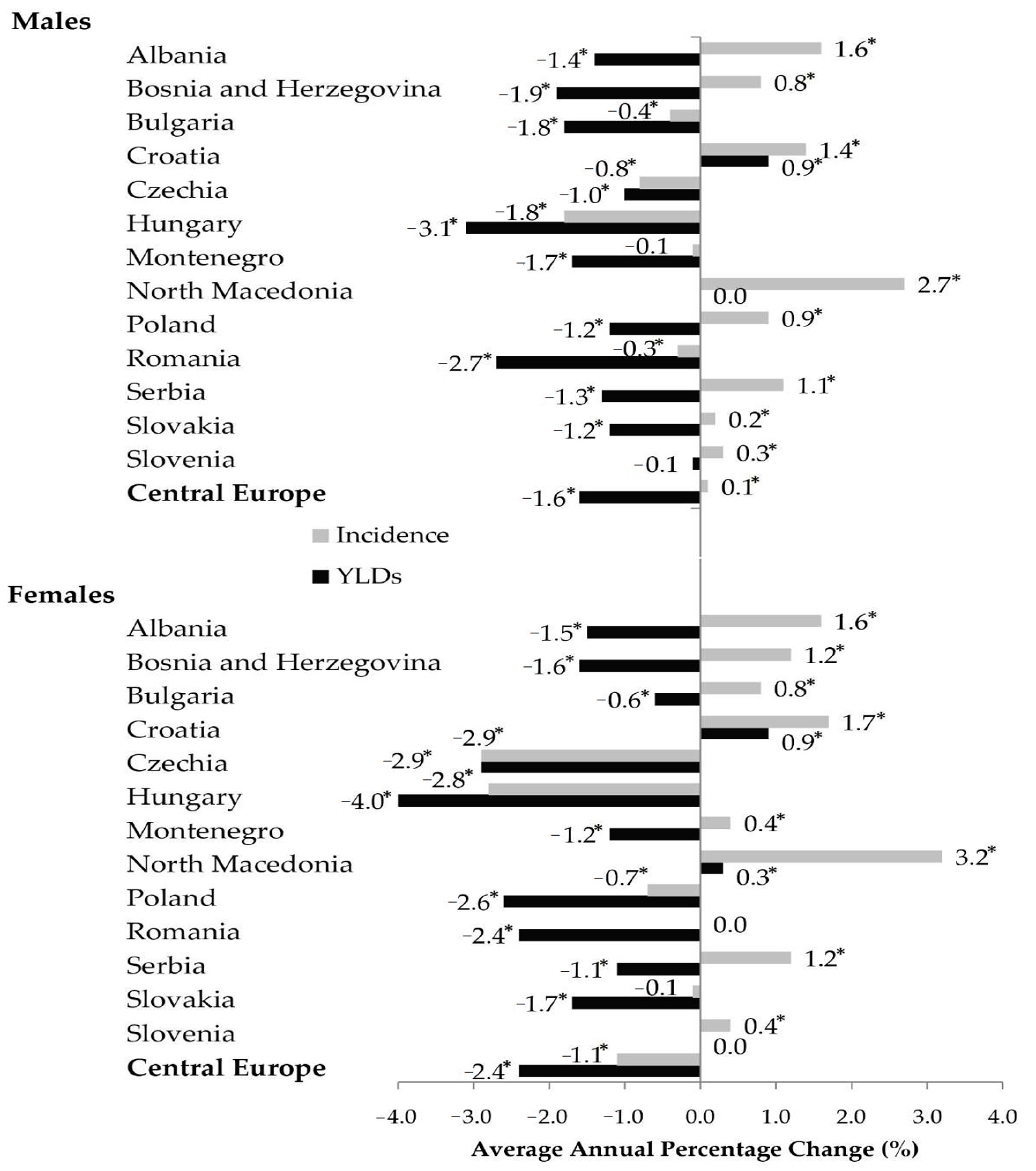

| Males | Females | |||||
|---|---|---|---|---|---|---|
| Age | Age-Specific Rates | AAPC (95% CI) | Age-Specific Rates | AAPC (95% CI) | ||
| 1990 | 2019 | 1990 | 2019 | |||
| Incidence | ||||||
| 0–9 | 9.1 | 12.1 | +0.9 * (0.7 to 1.1) | 10.6 | 15.6 | +1.4 * (1.2 to 1.5) |
| 10–24 | 15.3 | 53.3 | −0.1 * (−0.2 to −0.0) | 35.8 | 47.0 | +1.0 * (0.9 to 1.1) |
| 25–49 | 179.5 | 161.3 | −0.7 * (−0.8 to −0.5) | 70.5 | 79.5 | 0.2 (−0.0 to 0.3) |
| 50–69 | 352.3 | 414.1 | +0.7 * (0.7 to 0.8) | 267.1 | 246.7 | −0.7 * (−0.9 to −0.5) |
| 70+ | 1028.9 | 1222.7 | +0.4 * (0.3 to 0.5) | 2536.1 | 1923.8 | −1.2 * (−1.4 to −0.9) |
| Age-standardized rates | ||||||
| All ages | 195.6 | 208.0 | +0.1 * (0.0 to 0.2) | 230.3 | 186.2 | −1.1 * (−1.2 to −1.0) |
| Years Lived with Disability | ||||||
| 0–9 | 0.7 | 0.7 | −0.1 (−0.4 to 0.1) | 0.8 | 0.9 | +0.4 * (0.1 to 0.6) |
| 10–24 | 6.1 | 4.1 | −1.6 * (−1.8 to −1.4) | 4.8 | 3.8 | −0.8 * (−1.1 to −0.6) |
| 25–49 | 36.4 | 18.8 | −2.8 * (−3.0 to −2.5) | 17.5 | 10.9 | −2.1 * (−2.4 to −1.7) |
| 50–69 | 106.1 | 68.2 | −1.5 * (−1.7 to −1.3) | 75.5 | 44.0 | −2.3 * (−2.7 to −2.0) |
| 70+ | 206.4 | 175.7 | −0.6 * (−0.9 to −0.4) | 494.9 | 266.4 | −2.2 * (−2.6 to −1.9) |
| Age-standardized rates | ||||||
| All ages | 43.2 | 28.3 | −1.6 * (−1.8 to −1.4) | 48.4 | 26.2 | −2.4 * (−2.7 to −2.2) |
Disclaimer/Publisher’s Note: The statements, opinions and data contained in all publications are solely those of the individual author(s) and contributor(s) and not of MDPI and/or the editor(s). MDPI and/or the editor(s) disclaim responsibility for any injury to people or property resulting from any ideas, methods, instructions or products referred to in the content. |
© 2023 by the authors. Licensee MDPI, Basel, Switzerland. This article is an open access article distributed under the terms and conditions of the Creative Commons Attribution (CC BY) license (https://creativecommons.org/licenses/by/4.0/).
Share and Cite
Ilic, I.; Ristic, B.; Stojadinovic, I.; Ilic, M. Epidemiology of Hip Fractures Due to Falls. Medicina 2023, 59, 1528. https://doi.org/10.3390/medicina59091528
Ilic I, Ristic B, Stojadinovic I, Ilic M. Epidemiology of Hip Fractures Due to Falls. Medicina. 2023; 59(9):1528. https://doi.org/10.3390/medicina59091528
Chicago/Turabian StyleIlic, Irena, Branko Ristic, Ivan Stojadinovic, and Milena Ilic. 2023. "Epidemiology of Hip Fractures Due to Falls" Medicina 59, no. 9: 1528. https://doi.org/10.3390/medicina59091528
APA StyleIlic, I., Ristic, B., Stojadinovic, I., & Ilic, M. (2023). Epidemiology of Hip Fractures Due to Falls. Medicina, 59(9), 1528. https://doi.org/10.3390/medicina59091528






